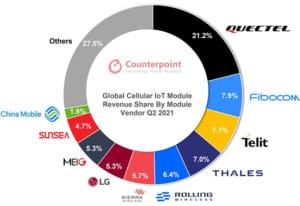Global cellular IoT module quarterly shipments reached the 100 million mark for the first time in Q2 2021, according to the latest research from Counterpoint’s Global Cellular IoT Module, Chipset and Application Tracker.
5G was the fastest growing technology YoY (+800%), followed by 4G Cat 1 (+100%). However, NB-IoT captured close to a third of the market in terms of shipments. China alone contributed nearly 85% of the total NB-IoT module shipments in this quarter and continues to be the leading geography for cellular IoT use-cases and deployments.
Commenting on the market dynamics, research analyst Soumen Mandal said,
“Quectel, Fibocom and Telit are the top three players in global cellular IoT module revenue rankings, capturing nearly 40% of the total revenue during Q2 2021.”
Quectel cellular IoT revenue grew 49% YoY during the quarter due to strong performance of NB-IoT and 4G Cat 1 modules in mainland China. Continuous rise in global presence, diversified product portfolio and increasing partnerships with more IoT module ecosystem players helped Quectel increase its market share in Q2 2021 compared to the previous quarter. Moreover, Quectel entered IoT antenna services, offering more than 250 antenna options. These services can be an alternative revenue source in the coming years. The vertical integration will help Quectel establish itself as a “true IoT” component solutions vendor in the global market.
Fibocom was also able to increase its share in the global cellular IoT module market, cementing the second spot in our global rankings. The company saw strong demand for its 4G Cat 1 shipments during this quarter but also continued to expand its 5G modules portfolio, targeting multiple applications to closely compete with the likes of Quectel, Thales and MeiG.
Telit entered the top three rankings of cellular IoT module vendors riding on its strong performance in 4G Cat 1 and LPWA modules. Moreover, Telit launched smart modules and NB-IoT modules recently following in Chinese module players’ footsteps. These modules will give Telit a boost across North America and Europe in the coming quarters.
Thales’ cellular IoT module revenue grew 47% YoY. 4G Cat 1, 5G and smart modules are expected to help Thales regain market share in coming quarters, with strong traction across the developed markets like Europe, North America and Japan.
Rolling Wireless and MeiG are some notable players among the Top 10 cellular IoT module vendors which are improving performance continuously. Rolling Wireless is purely focussed on automotive applications, whereas MeiG is more focussed on POS, telematics, industrial and router/CPE applications.

Global Cellular IoT Module Revenue Share by Module Vendor, Q2 2021
Commenting on the cellular IoT chipset supplier landscape, vice president research Neil Shah said, “Qualcomm is leading cellular IoT chipset shipments share across most of the fast-growing advanced cellular technologies. This has helped Qualcomm increase its market share further by capturing nearly half of the cellular IoT chipset market.”
HiSilicon is the second-largest player in the cellular IoT chipset market, still holding the fort in the IoT segment. NB-IoT is contributing more than 90% of HiSilicon’s shipments. Going forward, HiSilicon is expected to surrender the NB-IoT leadership position to its homegrown competitor UNISOC.
The third-largest vendor, UNISOC, is the only one among the top five cellular IoT chipset players which grew by more than 100% YoY during the quarter. The recent module launches trend shows UNISOC is focussing more on NB-IoT and 4G Cat 1. Quectel, Neoway, Longsung and Open Luat are some notable players which launched UNISOC-based modules during this quarter. Moreover, UNISOC unveiled Release 16 supported 5G chipset platform V516 in August. It is expected to help UNISOC increase market share in 5G applications such as manufacturing, port surveillance, grid monitoring, telehealth and patient monitoring.”
Overall module ASP increased by 5% YoY due to rising 5G shipments and semiconductor shortages. The ASP for 5G modules reached sub-$150 for the first time in Q2 2021. The second half of this year will provide momentum for 5G module adoption as most of the modules will come under production by then. However, the global cellular IoT module market will be more prone to supply shortages in Q3 2021 compared to Q2 2021.












